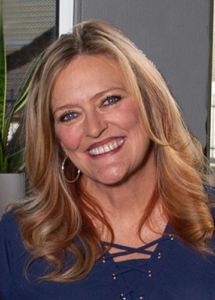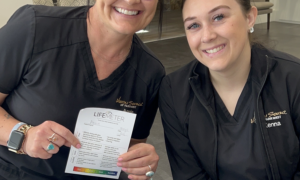
A patient works with a contact lens technician in Dr. Sorrenson’s office. Dr. Sorrenson says that carefully tracking your annual contact lens sale supply rate, and trying your best to capture these sales before the patient leaves your office, can make a huge difference to practice efficiency and profitability.
By Laurie Sorrenson, OD, FAAO
April 12, 2023
In my previous post, I discussed the first of two easy-win questions I ask every OD I consult with: “What is your retinal image capture rate?”
The second question I always ask is: “Do you know your annual contact lens supply sale rate? If so, what is it?”
I have found few optometrists track this number. However, I have found that tracking this metric can lead to additional profitability and efficiencies.
Another metric that is easier to track is contact lens revenue in dollars divided by the number of contact lens exams. Management & Business Academy (MBA) data, which is from 2018, (so take this number with a grain of salt) is $162.
In our practice, we’ve found that finalizing the prescription at the time of the initial exam and offering a significant discount of 20 percent, or more, to purchase an annual contact lens supply are effective ways to improve both metrics.
I would recommend figuring out how to capture your annual contact lens supply rate within your EHR. Why? If you capture the annual contact lens supply sale at the time of the initial exam, the supply can be shipped to the patient, the amount of staff time is minimized and you take the patient out of the market for a year.
If you don’t sell the contacts at the time of the exam, or you only sell a three-month or six-month supply, the potential increases for having to pay for extra staff time to answer the phone, process an order, check an order in, notify the patient, bag up the contacts, dispense the contacts, check to see if there is a balance, etc. Using a service like CLX, Abby, MARLO, LensFerry, Dr. Contact Lens, or another, can help with these added tasks, but not eliminate them.
Selling an annual supply at the time of the exam eliminates this unprofitable extra staff time. I believe patients want you to finalize their Rx at the time of the exam whenever possible and get their contacts to them ASAP!
Here are a couple ways you can start tracking your annual contact lens supply rate. One, and the one I really recommend, is to create a separate annual contact lens supply billing code for every order of contacts you sell. This requires some work upfront, but will save you time in the future and enable you to track your annual supplies.
Other Articles to Explore
For example, if I use a number code like 405 for one box of a monthly contact lens, then I would create a code 4405 for an annual contact lens supply of that same contact lens. If it is for a daily contact lens, then I would start the code with an 8. If you use letter codes, then I would just add the word “year,” “annual,” or an abbreviation to the original one-box code.
We also have a standalone billing code, “year supply cls.” We use that when a patient only uses contacts for one eye or they have two different types of lenses. However, we even have annual supply codes for spheres in one eye and torics in the second eye for the same brand for our most commonly used contacts.
Improving your annual contact lens supply sale rate can really increase revenue and make your office more efficient. Consider adding this metric as your goal for this quarter!
 Laurie Sorrenson, OD, FAAO, is president of Lakeline Vision Source in Cedar Park, Texas, and the Professional Editor of Review of Optometric Business (ROB). To contact her: lsorrenson@gmail.com.
Laurie Sorrenson, OD, FAAO, is president of Lakeline Vision Source in Cedar Park, Texas, and the Professional Editor of Review of Optometric Business (ROB). To contact her: lsorrenson@gmail.com.

























